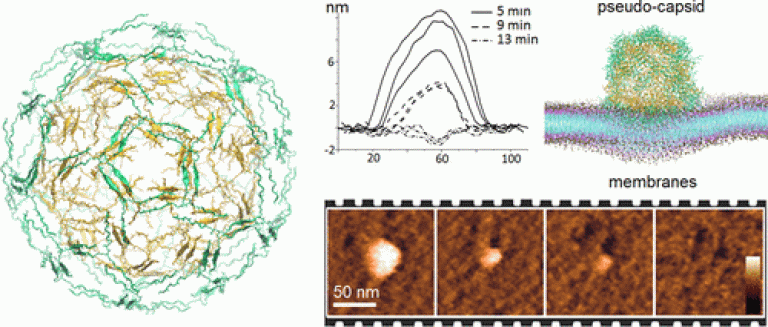UCL researchers receive National Physics Laboratory's most prestigious award
11 November 2021
An interdisciplinary team including London Centre for Nanotechnology at UCL and UCL Physics & Astronomy researchers won the National Physics Laboratory's Rayleigh Award for bioengineering antimicrobials that are inspired by viruses.

Professor Bart Hoogenboom (London Centre for Nanotechnology at UCL and UCL Physics & Astronomy) and Katharine Hammond (research scientist at the National Physics Laboratory – NPL – and PhD student at the London Centre for Nanotechnology at UCL and UCL Physics & Astronomy) were part of the team of researchers who won the 2021 Rayleigh Award for their paper demonstrating how bioengineering and multi-modal measurements can offer innovative routes to new therapies against infectious diseases.
The paper outlined a first-in-class antimicrobial agent, developed from two of four major classes of molecules highlighted in the UK government’s 2016 antimicrobial resistance (AMR) review as the most commercially promising in the fight against AMR. However, its main value is to support the development of other antimicrobial agents in a high-throughput manner.
Katharine Hammond added: “One of the challenges with antibiotics is to make sure they reach bacteria at a local concentration that is high enough to cause damage. By having antimicrobial molecules packed in a virus-like sphere, the multiple molecules in this sphere can reach bacterial membranes together instead of being diluted, and thereby have a most disruptive impact.”
The interdisciplinary team, comprised of researchers from UCL, NPL, University of Cambridge, University of Exeter and King’s College London, adopted the geometric principles of virus architecture to engineer a synthetic protein shell (capsid), enclosing a small molecular motif found in human cells.
When multiple copies of this motif are combined within a capsid, it delivers an influx of high antimicrobial doses in where it attaches on a bacterial cell. UCL scientists used a type of “feeling microscopy” to trace the contours of a bacterial model surface, and thereby visualised how the capsids landed on their targets and created nanometre-size holes, which ultimately are lethal to the bacteria.
About the Rayleigh Award
The Rayleigh Award is NPL's most prestigious internal award, given yearly to the author(s) of the most outstanding published paper. The award is highly competitive, and papers are judged on their creativity and novelty, the extent and quality of the scientific investigation, potential impact, and clarity and accessibility. The Rayleigh Award is named after John William Strutt Rayleigh, Chairman of the Government Committee that recommended the formation of NPL in 1897.
Links
- Engineering Chirally Blind Protein Pseudocapsids into Antibacterial Persisters, published in ACS Nano 14, 1609 (2020)
- ACS Nano perspective on this paper
- National Physical Laboratory (NPL)
- Professor Bart Hoogenboom’s academic profile
- UCL Physics & Astronomy
- London Centre for Nanotechnology
- UCL Mathematical & Physical Sciences
Image
- Schematic view synthetic protein shell (left); its protrusion above a model bacterial surface as a function of time (top, middle); a snapshot of a computer simulation showing the shell on top of this surface (top, right); and a sequence of microscopy images showing how the protein shell integrates in the surface. Image courtesy of Irene Marzuoli and Katharine Hammond.
Videos
- Computer simulations showing the synthetic protein shell as it makes contact with the target surface, at lower and higher magnifications. Video courtesy of Irene Marzuoli.
 Close
Close

